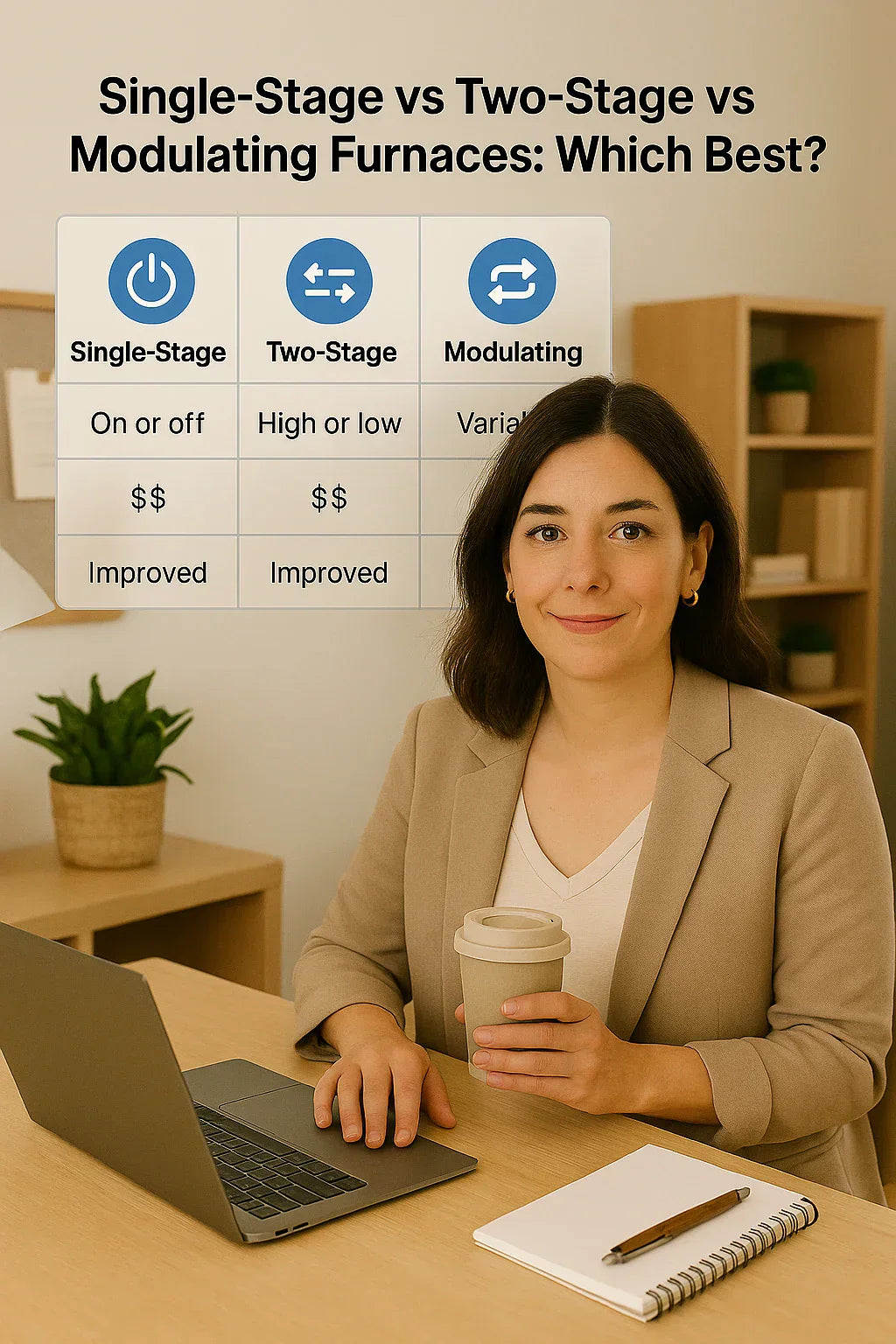🏠 Introduction: Not All Furnaces Are Created Equal
When choosing a new furnace, it's not just about size or brand — how your furnace operates from moment to moment can dramatically impact comfort, energy use, and long-term cost. This is where staging comes into play.
In this Savvy Mavi guide, we’ll break down:
-
The differences between single-stage, two-stage, and modulating furnaces
-
Pros and cons of each type
-
Cost comparisons
-
How to decide which option fits your home best
🔄 What Is Furnace Staging?
Staging refers to how a furnace controls its heating output:
-
Single-stage: One heat output level (100%).
-
Two-stage: Two levels (high and low).
-
Modulating: Continuously variable output.
The more stages, the more precisely your furnace can respond to your home’s real-time heating needs.
Learn more from Energy Star’s furnace performance breakdown.
🔥 Single-Stage Furnaces
How They Work:
-
Operate at full blast whenever heating is required.
-
Turns off once the thermostat setpoint is reached.
Pros:
-
Lower upfront cost
-
Simple design; fewer parts to fail
-
Easy to install and repair
Cons:
-
Short cycling (frequent on/off)
-
Temperature swings
-
Noisy operation
-
Lower efficiency in mild weather
Ideal for:
-
Smaller budgets
-
Warm climates with minimal heating needs
🔥🔥 Two-Stage Furnaces
How They Work:
-
Operate at ~65% capacity most of the time.
-
Shift to full capacity only during very cold conditions.
Pros:
-
Improved temperature consistency
-
Quieter operation
-
Better humidity control
-
Higher efficiency compared to single-stage
Cons:
-
Higher initial cost
-
More complex components
Ideal for:
-
Moderate to cold climates
-
Homeowners seeking better comfort and energy savings
🔥🔥🔥 Modulating Furnaces
How They Work:
-
Continuously adjust output in tiny increments (as little as 1% changes).
-
Maintain near-perfect indoor temperatures.
Pros:
-
Ultimate comfort and consistency
-
Quietest operation
-
Highest energy efficiency
-
Longest equipment lifespan due to minimal cycling stress
Cons:
-
Most expensive upfront
-
Requires expert installation and precise tuning
Ideal for:
-
Cold climates
-
High-performance homes
-
Homeowners planning to stay long-term
Explore deeper technical details at HVAC.com’s modulating furnace guide.
💸 Cost Comparison
| Furnace Type | Average Unit Cost | Installed Cost |
|---|---|---|
| Single-Stage | $1,500 - $3,000 | $3,000 - $5,000 |
| Two-Stage | $2,500 - $4,500 | $4,500 - $7,000 |
| Modulating | $4,000 - $6,500 | $6,500 - $10,000 |
🌎 Efficiency Differences
| Furnace Type | AFUE Range |
| Single-Stage | 80% - 95% |
| Two-Stage | 90% - 97% |
| Modulating | 95% - 98.5% |
Higher stages generally deliver better seasonal efficiency due to longer, gentler heating cycles.
🧯 Staging and Home Comfort
Humidity Control:
-
Two-stage and modulating furnaces excel at controlling indoor humidity.
-
Essential for allergy sufferers or those sensitive to dry winter air.
Noise Levels:
-
Modulating: Whisper quiet.
-
Two-stage: Noticeably quieter than single-stage.
-
Single-stage: Most noticeable startup noise.
🛠️ Installation Matters
-
Modulating and two-stage systems require precise ductwork design.
-
Professional sizing and commissioning are critical for full performance.
-
Poor installation can nullify the advantages of advanced staging.
For installation best practices, see ACCA Quality Installation Standards.
🏅 The Savvy Mavi Takeaway
-
Single-stage: Budget-friendly, simple, best for mild climates.
-
Two-stage: Sweet spot for most homeowners balancing comfort, cost, and efficiency.
-
Modulating: Premium choice for those prioritizing ultimate comfort, quiet operation, and energy savings.
Staging is one of the biggest comfort upgrades available. Carefully evaluate your climate, budget, and long-term plans to choose the right system for your home.
In the next topic we will know more about: Furnace Installation Costs in 2025: Real-World Estimates & Pro Tips







